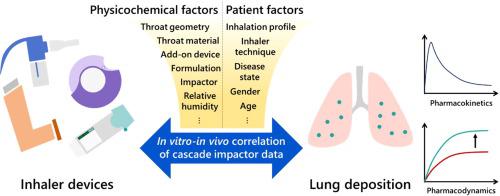Advanced Drug Delivery Reviews ( IF 15.2 ) Pub Date : 2021-08-27 , DOI: 10.1016/j.addr.2021.113952 Michael Yee Tak Chow 1 , Waiting Tai 1 , Rachel Yoon Kyung Chang 1 , Hak-Kim Chan 1 , Philip Chi Lip Kwok 1

|
In vitro-in vivo correlation is the establishment of a predictive relationship between in vitro and in vivo data. In the context of cascade impactor results of orally inhaled pharmaceutical aerosols, this involves the linking of parameters such as the emitted dose, fine particle dose, fine particle fraction, and mass median aerodynamic diameter to in vivo lung deposition from scintigraphy data. If the dissolution and absorption processes after deposition are adequately understood, the correlation may be extended to the pharmacokinetics and pharmacodynamics of the delivered drugs. Correlation of impactor data to lung deposition is a relatively new research area that has been gaining recent interest. Although few in number, experiments and meta-analyses have been conducted to examine such correlations. An artificial neural network approach has also been employed to analyse the complex relationships between multiple factors and responses. However, much research is needed to generate more data to obtain robust correlations. These predictive models will be useful in improving the efficiency in product development by reducing the need of expensive and lengthy clinical trials.
中文翻译:

口服吸入药用气溶胶级联冲击器数据的体内外相关性
体外-体内相关性是在体外和体内数据之间建立预测关系。在口服吸入药物气溶胶的级联冲击器结果的背景下,这涉及将发射剂量、细颗粒剂量、细颗粒分数和质量中值空气动力学直径等参数与体内联系起来来自闪烁显像数据的肺沉积。如果充分了解沉积后的溶解和吸收过程,则相关性可以扩展到所递送药物的药代动力学和药效学。撞击器数据与肺沉积的相关性是一个相对较新的研究领域,最近引起了人们的兴趣。虽然数量很少,但实验和元- 已经进行了分析以检查这种相关性。人工神经网络方法也已被用于分析多个因素和响应之间的复杂关系。然而,需要大量研究来生成更多数据以获得稳健的相关性。这些预测模型将有助于通过减少昂贵且冗长的临床试验的需要来提高产品开发的效率。











































 京公网安备 11010802027423号
京公网安备 11010802027423号